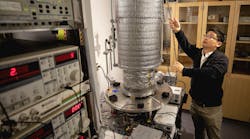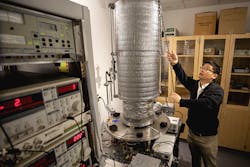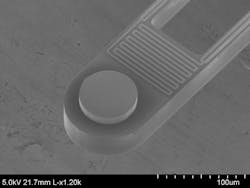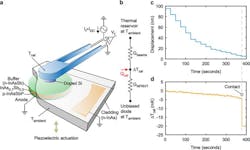The idea of being able to use an LED which has been deliberately wired backwards for cooling sounds like some sort of joke, but it’s not. (Several years ago, there was a “joke” datasheet about a dark-emitting diode, or DED, which created an aura of darkness, but this is very different.) Researchers at the University of Michigan (Ann Arbor) have used an infrared light-emitting diode (IR LED) with its electrodes reversed to cool another device just nanometers away (Fig. 1).
1. Linxiao Zhu shows the experimental platform that housed the calorimeter and photodiode. This system can damp vibrations from the room and building, steadily holding the two nanoscale objects 55 nm apart. (Source: Joseph Xu)
The physics supporting this counterintuitive technique is actually well-established and is based on the work of Arthur Ashkin, (who also shared the Nobel Prize in Physics in 2018 for his work on optical tweezers, see Reference). This laser-based cooling technique is already used for compact, all-optical, vibration-free cryogenic devices as well as exploration of states of matter such as Bose-Einstein condensates.
Reversing the positive and negative electrical connections on the IR LED makes it behave as if it’s at a cooler temperature than the ambient. The reverse connection not only keeps it from emitting light, but also can induce the LED to suppress the thermal radiation that it would be emitting.
Using an LED for cooling involves more than just placing the LED near the heat source. Key to the experiment and demonstration of active nanophotonic cooling is the fabrication of a nanocalometric device (Fig. 2). This was placed next to a small LED, which was about the size of a grain of rice. When the LED was reverse-biased, it began acting as a very low-temperature object and absorbed photons (representing energy) from the calorimeter.
2. This electron-microscope image shows the nanocalorimeter with its sensing area of 80 µm in diameter. (Source: Linxiao Zhu)
A subwavelength nanometer-size gap is needed between the LED and the calorimeter to enable near-field (evanescent coupling) spacing; it’s positioned by a piezoelectric actuator and prevents heat energy from flowing back to the calorimeter via conduction (Fig. 3). The team’s data, as reported in their paper published in Nature, “Near-field photonic cooling through control of the chemical potential of photons,” implies cooling of 6 W/m2, an effect that’s equivalent to a cooling metric of 1000 W/m2.
3. Measuring the radiative conductance: Schematic of the setup for measuring radiative conductance GNFRHT (a). The emitting area of the photodiode is located below the n-InAs layer (b). In (c), the effective thermal-resistance network shows the major heat transfer pathways, where the calorimeter has a power input (Qcal) due to a current supplied to the platinum resistor. And (d) illustrates simultaneously recorded displacement and calorimeter temperature change (∆Tcal) during a GNFRHT measurement. (Source: University of Michigan)
The researchers showed that when the calorimeter and reverse-biased LED are in each other’s near-field, with a vacuum gap between them of just tens of nanometers, this evanescent cooling occurs via two mechanisms. One is photon tunneling (which enhances the transport of photons across nanoscale gaps), while the second is suppression of photon emission from the photodiode (due to a change in the chemical potential of the photons under an applied reverse bias).
This demonstration of active nanophotonic cooling without using coherent laser radiation may become the foundation for possible use of nanoscale photonics and optoelectronics to deliver solid-state on-chip device cooling.
Reference
Laser Focus World, “Optical Cooling: All-optical cryogenic cooling of sensors eliminates vibration.”




